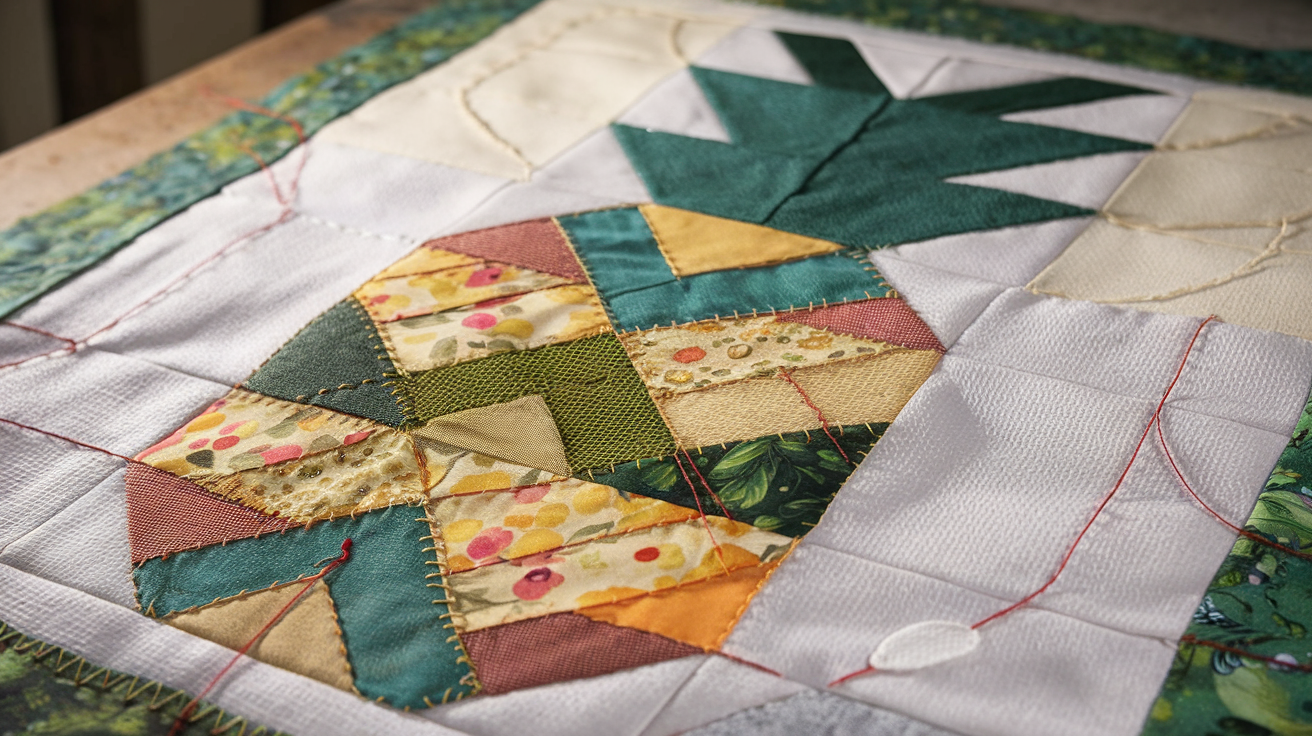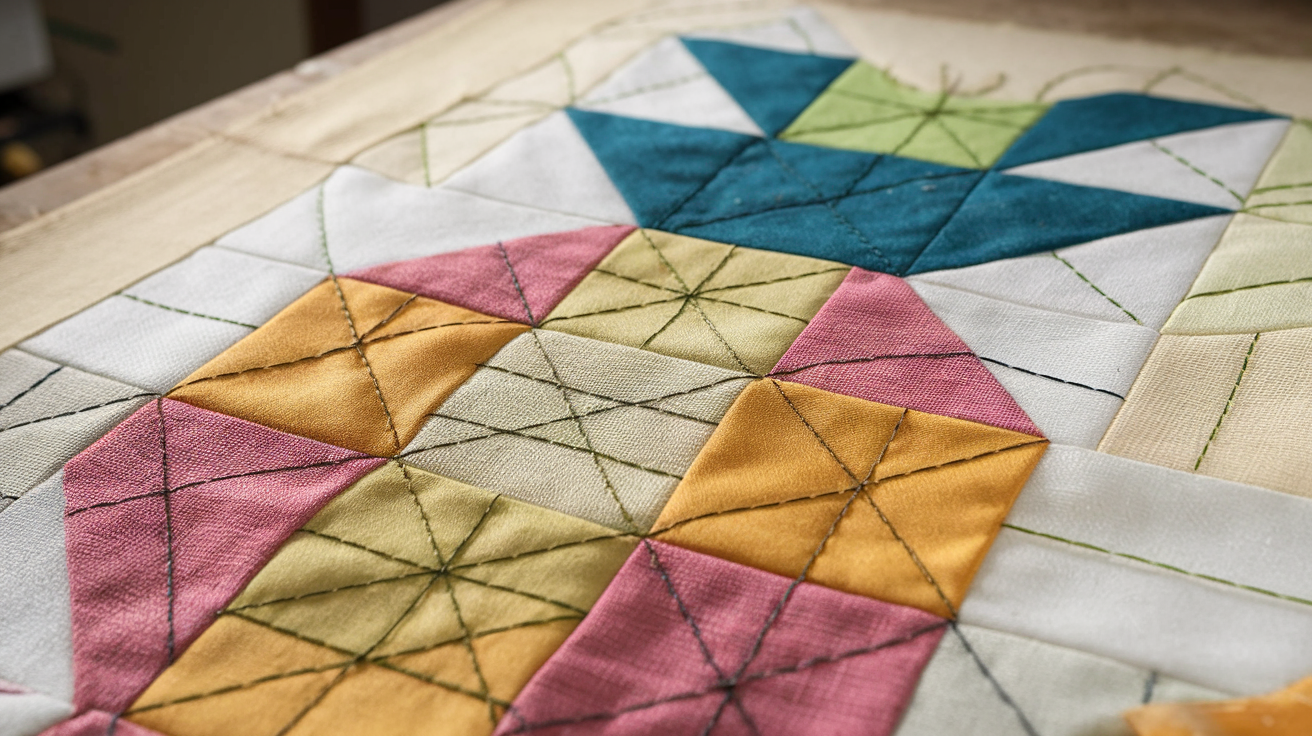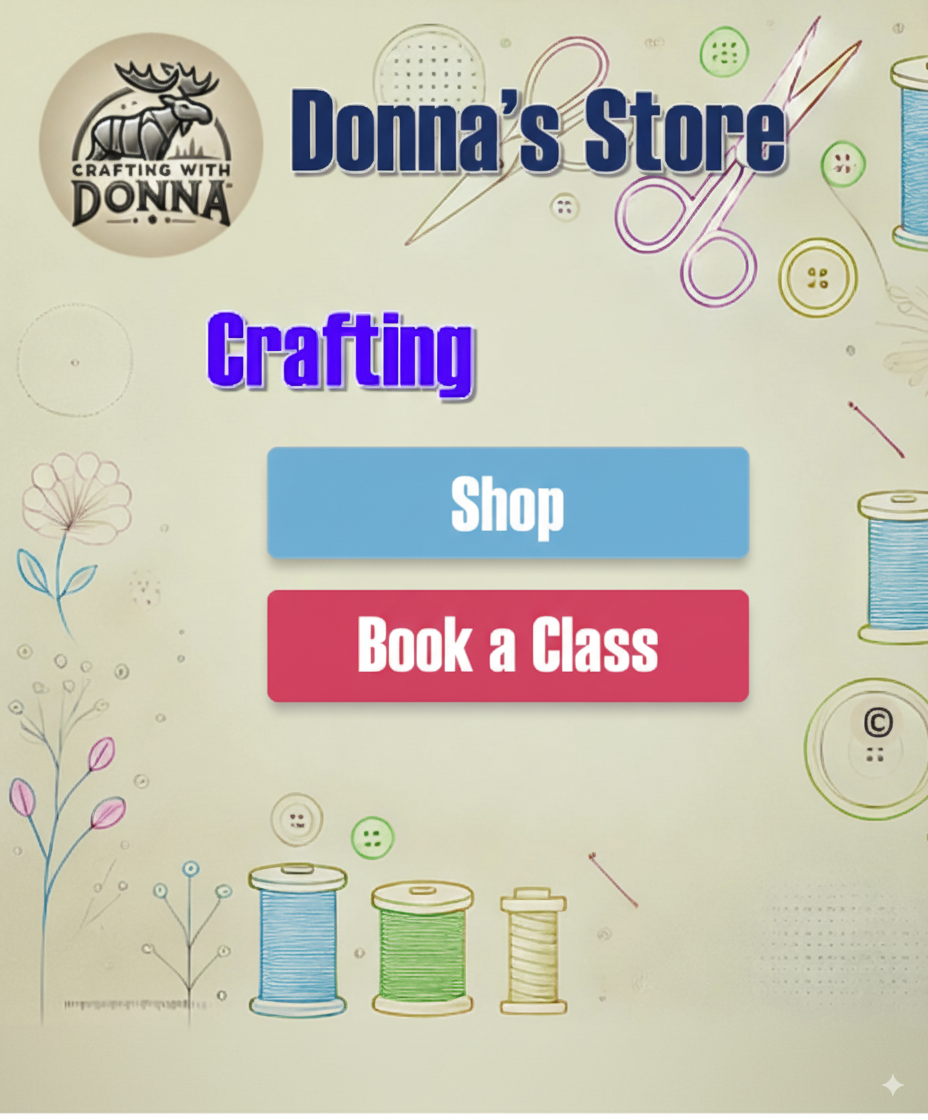How To Make A Scrappy Pineapple Quilt Block

Scrappy pineapple quilt block enthusiasts discover a lively way to transform leftover fabric scraps into dynamic quilt art with each layered block. Strip piecing introduces variety and color balance, as sewing sequential rounds of strips and trimming at a 45-degree angle produces signature “pineapple” radiance.
Rely on well-pressed seams for flat construction and employ diverse strip widths to add unique texture and visual interest.
Maximize scrap usage for environmentally friendly textile art while adding your own creative expression.
Whether you’re a confident beginner or seasoned quilter, this process rewards patience and results in a cohesive quilt pattern personalized by every fabric choice.
Creating a scrappy pineapple block is a rewarding journey into patchwork construction. This quilting tutorial guides you through layering fabric with precision, resulting in striking, multidimensional quilts.
Block assembly relies on accurate cuts and consistent pressing, ensuring each piece fits perfectly.
Starting with the Center
Fabric placement begins with a central square, the heart of your scrappy pineapple block.
This initial piece, cut from your stash, sets the stage for the surrounding fabric strips.
Aim for a square that allows ample room for layering subsequent rounds of fabric, ensuring clean edges for each subsequent addition.
Layering Fabric Strips
Strip piecing involves sewing strips sequentially around the central square.
The quilt pattern dictates adding strips in rounds, building outward to create the pineapple effect. Varying strip widths injects personality and texture, making each block a unique piece of fabric art.
Precision in your quarterinch seams is paramount for a neat finish, supporting a truly unified quilt.
Trimming and Pressing
After each round of strip piecing, carefully trim your block at a 45-degree angle.
This step is fundamental to achieving the characteristic “pineapple” shape and maintaining the correct block size.
Pressing seams flat after every sewing step prevents bulk and ensures your layered blocks lie smoothly.
Consistent squaring up is key for alignment when joining blocks, contributing to a cohesive look.
Achieving Color Balance
Creative color choices are central to the scrappy pineapple block’s appeal. By selecting a diverse range of fabric scraps, you can create stunning color arrangements and ensure good color balance.
Mixing light, medium, and dark values adds depth to your design, enhancing its visual interest. This thoughtful approach results in a more dynamic and engaging final quilt, making your project a standout example of creative patchwork.
Squaring Up the Block
The final step in creating your scrappy pineapple block involves squaring up the unit.
This ensures all your blocks are the same block size, which is essential for seamless quilt assembly.
Using a ruler or a specialized Pineapple Trim Tool aids in achieving perfect 90-degree angles and clean edges.
This attention to detail guarantees your layered construction will fit together beautifully for a truly professional finish.
Choosing Fabric Scraps
Selecting the right fabric scraps is the first exciting step in creating your own scrappy pineapple block. This process offers endless possibilities for personalization, allowing you to craft a truly unique quilt.
Combining contrasting textures for visual interest is key.
Texture and Visual Interest
Contrast is essential when choosing your fabric scraps for a striking visual.
Mix bold cottons, textured linens, or smooth silks for standout visual impact and tactile depth.
These varied materials contribute to the overall visual design of your quilt, making each section more engaging.
Maximizing Scrap Usage
Utilizing leftover fabric scraps from previous sewing projects significantly contributes to fabric waste reduction. This practice makes your quilt an environmentally friendly creation.
Gathering remnants from larger projects ensures you avoid unnecessary waste and maximize your stash.
Building Color Depth
A successful scrappy pineapple block relies on thoughtful color arrangement.
Aim for a mix of light, medium, and dark values to create captivating depth.
This strategic variation in color and hue ensures your layered blocks have a pleasing aesthetic and a cohesive look.

Creative Color Arrangement
The color arrangement in a scrappy pineapple block transforms fabric scraps into a visually engaging quilt with depth and mood. Gradient effects are achieved by placing similar hues side-by-side, guiding the eye smoothly through sequential rounds and fostering a sense of harmony and cohesion in layered blocks.
Contrasting colors, such as complementary pairs or bold brights against neutrals, create impactful focal points and energize patchwork compositions, amplifying the creative color play in your quilt pattern.
The perceived warmth or coolness in color choice shapes the emotional tone; reds and yellows bring coziness, while blues or greens offer serenity.
Previewing color arrangements using a digital mockup or coloring sheet lets you test combinations and fine-tune your creative layout before sewing, ensuring a unified quilt full of personality. Fabric placement is key to achieving the desired visual design, making each unique quilt a testament to your personal style.
Exploring Color Balance
Achieving perfect color balance within your quilt pattern involves more than just pleasing aesthetics; it’s about how different values and hues interact.
When you vary value and vary hue within your fabric scraps, you introduce depth and cohesion to your finished piece. Consider using techniques that create visual interest and texture through deliberate color arrangement.
This attention to detail ensures your quilt will be a beautiful example of creative patchwork.
Even a confident beginner can create stunning results with patience and careful planning.
Scrap fabric utilization becomes an art form with this approach.
Enhancing Visual Appeal
To enhance visual appeal, embrace the opportunity to vary value and vary hue across your fabric scraps. This strategy introduces depth and cohesion, making your finished quilt pattern exceptionally engaging.
Experiment with strip widths, ranging from 25 inches to 2 inches, to infuse your design with unique visual interest and texture. Previewing potential block layouts using a digital mockup or even colored pencils on paper allows you to confidently adjust your piece placement before the first stitch.
This meticulous preparation ensures a truly unified quilt, reflecting thoughtful color arrangement and maximizing scrap fabric utilization.
Step-by-step Strip Piecing
Precision is the foundation for successful strip piecing in a scrappy pineapple block, starting with accurately cut strips to the same width using rotary cutters or specialty rulers for clean edges.
Consistent quarter-inch seams throughout each round of strip piecing ensure uniform block size and smooth block assembly, aiding even beginner quilters in creating professional-quality layered blocks.
Pressing seams to one side and alternating direction between strips is key to minimizing bulk, resulting in a flatter, tidier quilt pattern. Sequential rounds of sewing and trimming with each fabric strip build multidimensional results while maintaining accuracy.
For added visual interest, vary strip widths when possible, always keeping precise measurement as your guide for mastering this rewarding technique in scrap quilting. This methodical approach is essential for achieving the desired block size and a clean finish, making the process enjoyable for any beginner quilter.
Mastering Accurate Cutting and Sewing
Accurately cut strips are paramount for best results in your strip piecing, with strip cutters or pre-cuts like Honey Buns proving particularly helpful tools.
When you vary value and vary hue in your fabric choices, you introduce depth and cohesion, essential for any successful quilt design.
Consistent squaring up of each block is also important, contributing to the overall flatness and alignment needed for smooth quilt assembly.
Preview layouts meticulously, whether through a digital mockup or a simple coloring sheet, to confirm your color arrangement and ensure a visually pleasing outcome for your unique quilt. This careful preparation enhances visual design and promotes fabric waste reduction.
Trimming and Pressing for Success
When you are focused on strip piecing, precise trimming and pressing are indispensable steps for a high-quality finish.
Accurately cut strips are the first requirement, ensuring your quarter-inch seams are consistent and your resulting block size is uniform. With each new fabric strip added in sequential rounds, a clean press of the seam allowances is necessary to reduce bulk and create a flat surface for the next addition.
This methodical process builds the layered construction characteristic of the scrappy pineapple block, yielding multidimensional results.
The Pineapple Trim Tool or similar specialty rulers can greatly assist in maintaining consistent squaring, a key element for a cohesive look in your patchwork creation.
This technique is a fantastic way to maximize scrap usage and create a truly environmentally friendly quilt.
- Varying hues and values in fabric scraps introduces depth and cohesion to a quilt.
- Consistent quarter-inch seams and accurate cutting are essential for uniform block size and a professional finish.
- Pressing seams to one side and alternating directions minimizes bulk for a flatter quilt.
- Previewing color arrangements digitally or on paper helps fine-tune the creative layout before sewing.
Mastering Sequential Rounds
Consistent results in a scrappy pineapple block depend on careful strip piecing during every sequential rounds. A quilting tutorial expert stresses that before adding each strip, you must align raw edges precisely to uphold the block’s layered construction and maintain clean edges throughout.
Avoid fabric distortion by handling with accuracy and patience.
Leader/ender strips—short fabric scraps sewn before and after your main work—reduce thread tangles and streamline transitions between rounds, minimizing starts and stops during your sewing project.
This simple method keeps the block assembly continuous and orderly, fostering both efficient quilting and less fabric waste reduction for a unified quilt result. This process helps achieve a cohesive look and is a great way to maximize scrap usage and create a unique quilt.
Precision in Fabric Placement
Complete cohesion in your quilt pattern hinges on thoughtful fabric placement at each step.
Fabric placement tips from advanced quilters focus on evaluating color balance, alternating pattern and solid fabrics to enhance depth and visual interest in your block layout. Butted seams are essential—each new strip must nest smoothly into the previous layer, avoiding unsightly gaps and ensuring crisp, clean edges.
Contrast between carefully chosen fabrics amplifies texture and multidimensional results.
Pressing seams diligently after every round not only flattens layers but also aids in maintaining block size accuracy, allowing even a confident beginner to achieve professional outcomes as they transition toward final quilt assembly.
For a truly cohesive look, consider creative color arrangements and how different fabric combinations contribute to the overall visual design. Practicing these quilting techniques will lead to a more beautiful patchwork.
- Accurate alignment of raw edges is crucial for maintaining the block’s layered construction and clean edges during sequential rounds.
- Leader/ender strips are used to reduce thread tangles and streamline transitions between rounds, minimizing starts and stops.
- Evaluating color balance and alternating pattern and solid fabrics enhances depth and visual interest in the block layout.
- Pressing seams after every round aids in maintaining block size accuracy and contributes to a cohesive look.




